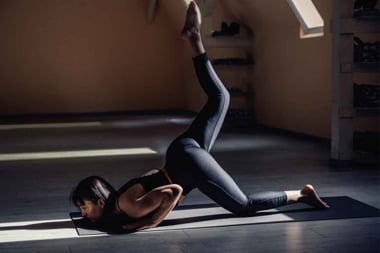
What's a family picnic without badminton or bocce? Before you play picnic sports, prevent injury by doing some easy warmup exercises.
Summertime and the exercisin’ is easy. Now’s the time to get outdoors to play some picnic sports with the family. But first, be sure to prevent injury by doing warmup exercises.
Whether you’re at a park or in your own backyard, you can get in a light or more intense workout with several summer sports, depending on your level of exertion.
Keep in mind that regardless of what type of exercise you’re doing, it’s crucial to warm up for five to 10 minutes beforehand to get your muscles ready for action and reduce the risk of injury.
Badminton
The rundown
Hugely popular in Asia, badminton is an Olympic sport. At the 2012 Olympic Games in London, players are expected to hit shuttlecocks (or birdies) at speeds exceeding 400 kilometres per hour. The object of the game is to win the best of three 21-point sets. Points are scored when the shuttle is hit or served across a net but not properly returned.
Equipment required
Badminton racquets, a birdie, and a net (or a string tied about 5 feet (1.5 m) off the ground).
Health benefits
Improved cardiovascular endurance, balance, agility, hand-eye coordination, and core strength.
Get ready to hit the birdie with these exercises.
Walking lunges
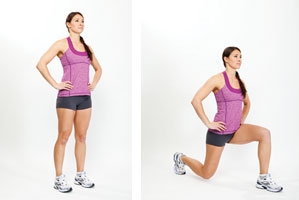
Come up out of the lunge and take a big step forward on the other side.
Repeat, keeping your shoulders back and your belly button pulled in toward your spine. Keep your torso straight upright, as if you’re riding in an elevator; in other words, avoid leaning forward. Continue for 2 to 3 minutes, resting as needed.
Shadow swings
Use your racquet to hit shadow forehands and backhands in the air, using the same technique as you would in a game.
Cross-over jacks

Another version of jumping jacks, these simply involve crossing one leg in front of the other when you bring your feet together when you land.
Alternate the foot that lands in front. Aim for 1 minute.
Bocce
The rundown
Dating back to 5000 BC, bocce is especially common in Italy, which started a league in 1947. It can be played on nearly any hard surface or on a level grassy area.
The game begins with a player throwing a target ball, or pallino onto the court (or grass). Opponents take turns trying to toss or roll their game balls as close as possible to the pallino. Just like in curling, opponents’ balls can be knocked out. The balls closest to the pallino score points, but only one team scores points during each frame. Bocce games are generally played to 12 points.
Equipment required
Eight game balls (four of one colour and four of another) and one smaller one for the pallino, divided evenly among two, four, or eight players. (Bocce balls can be bought in sets.)
Health benefits
Enhanced hand-eye coordination, balance, and core and upper body strength, plus mental acuity from strategic play.
Warm up for bocce with these exercises.
Arm swings

- Stand with feet hip-width apart. Gently wrap your arms around your body as if you’re giving yourself a hug.
- Release, open the arms wide, and do it again, alternating which arm is on top.
- Repeat, hugging more tightly and gaining momentum with each movement. Continue for 1 minute.
Power walk or light jog
Power walk or jog back and forth across the field or playing area for at least 3 to 5 minutes.
Arm circles
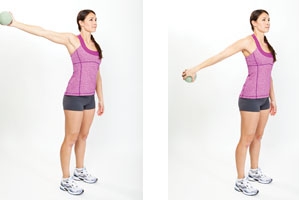
- Hold a bocce ball in one hand, and do full arm circles in both directions. (Lead with your pinky finger for backward circles and your thumb for forward ones.)
- Change sides and repeat for 1 minute on each side.
Trunk rotations

- Stand on the spot with feet hip-width apart, knees slightly bent, and belly button pulled in to your spine.
- Bring your arms in front of your body, elbows bent and tucked in, and fists toward your face.
- Keep your hips perfectly still, and rotate your upper body from side to side for 1 minute.
Horseshoes
The rundown
The origins of this traditional pastime go back 2,000 years to a game called quoits, in which Roman soldiers would toss metal rings onto a stake. Horseshoes became a substitute when rings weren’t available, and the game has been a group favourite ever since.
Players toss, or “pitch,” horseshoes toward a stake. Points may be scored for horseshoes that land within 6 in (15 cm) of the stake (the closest to the stake gets one point), or encircling it (the beloved “ringer,” which earns three points). Players alternate pitching from one end of the court to the other until everyone has had a turn. Play continues until one team reaches 40 points or 40 shoes have been pitched.
Equipment required
Two stakes or sticks set 40 feet (12 m) apart ideally on a level surface, plus as many horseshoes as possible. (Official rules call for shoes that weigh close to 3 lb/1.4 kg.)
Health benefits
Improved upper body and core strength, as well as aim.
Warm up to safely pitch horseshoes with these exercises.
Squats with knees up
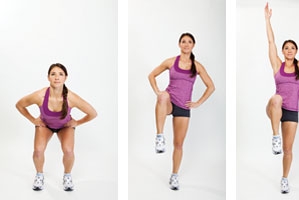
- Stand with your feet hip-width apart, bend your knees, and press your gluteal muscles out behind you, as if you’re about to sit down on a chair that’s just a little bit too far away.
- As you come up, lift one knee up to your chest while standing tall; alternate sides.
- Next, add the arms by reaching to the sky on the way up. Continue for 2 minutes, taking breaks if necessary.
Squats with legs to the side
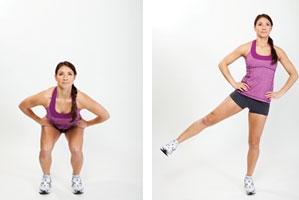
- This time come into a squat. On the way up, lift your right leg out to the right, keeping your foot flexed and bring it back with control. (Avoid letting it flop down.)
- Alternate sides for 2 minutes.
Rowing
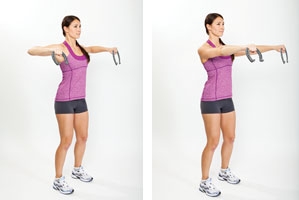
- Take a horseshoe in each hand. Stand with knees slightly bent and feet hip-width apart.
- Imagine you are rowing by pulling your elbows straight behind you as far as you can, squeezing the shoulder blades together. Avoid swinging the arms, but rather use clean, purposeful movements. Do a set; keep the horseshoes in line with your shoulders for 1 minute.
Croquet
The rundown
Don’t let the sport’s genteel image fool you; this can be an extremely competitive game of skill and strategy. The object is to score the most points by knocking a ball through the goals, called wickets, and into a final stake. The ball must pass through the wickets in a specific order and from the correct direction to count for a point.
Equipment required
An open, level grassy field and a croquet set consisting of two stakes, nine wickets, and mallets and balls.
Health benefits
Enhanced balance, core strength, and hand-eye coordination.
Get ready to swing a croquet mallet with these exercises.
Butt-kick skipping
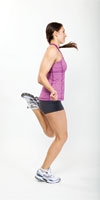
- Pretend you’re holding a skipping rope; turn your arms in small circles by your sides.
- While you turn your arms, hop from one leg to the other, bringing one heel up at a time right up to your gluteal muscles. Skip for 1 minute.
Low-impact skipping

- For low-impact movement, avoid jumping when skipping, but rather bring one heel up at a time in a hamstring curl while the other foot stays planted on the ground.
- Rotate the arms in both directions. Skip for 1 minute, taking short rests as needed.
Elbow circles

- Place your hands on top of each shoulder (right hand on right shoulder, left hand on left shoulder).
- Circle your elbows in both directions; do both sides simultaneously for 1 minute.
- Then rotate one side at a time for 1 minute.




